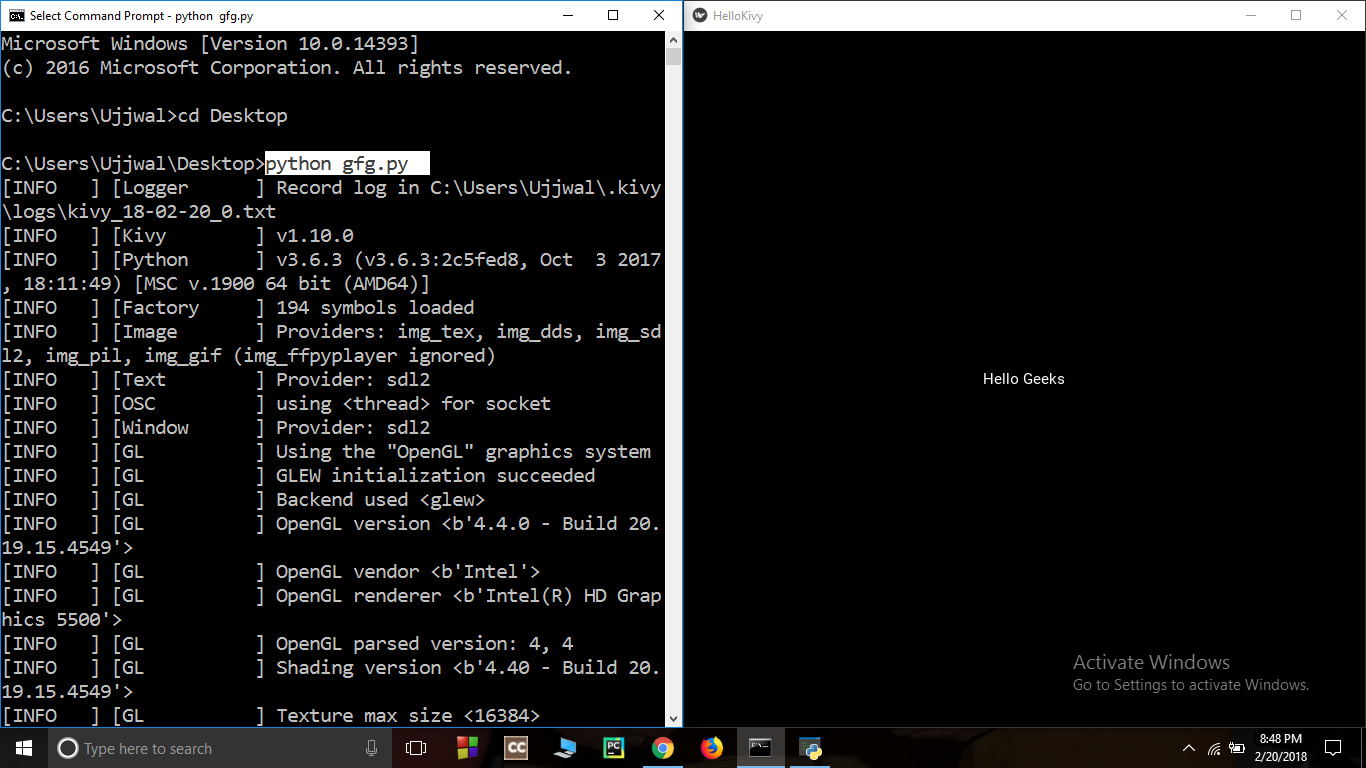Introduction to Kivy ; A Cross-platform Python Framework
Last Updated :
19 Mar, 2023
Kivy is an open-source, cross-platform Python framework used for developing multi-touch applications with a natural user interface. It allows developers to build applications that run on multiple platforms, including Windows, macOS, Linux, iOS, and Android.
- Kivy is based on the Model-View-Controller (MVC) architecture and uses a declarative language to define the user interface. The framework provides a set of widgets and tools for creating dynamic and responsive user interfaces, including buttons, labels, text inputs, and more.
- One of the main features of Kivy is its support for touch and gesture input, making it well-suited for developing applications for touch-based devices like smartphones and tablets. Kivy also supports other input methods such as mouse, keyboard, and gamepad.
- Kivy is built using OpenGL, which provides fast graphics rendering and enables developers to create visually appealing applications with smooth animations and transitions.
- Kivy is open-source and has an active community of developers who contribute to the framework, provide support, and share resources like tutorials and documentation.
Overall, Kivy is a powerful and versatile framework for building cross-platform applications with a natural user interface, making it a popular choice for developers looking to create multi-touch applications that run on multiple platforms.
Kivy is a graphical user interface open-source Python library that allows you to develop multi-platform applications on Windows, macOS, Android, iOS, Linux, and Raspberry Pi. The best thing about kivy is, it performs better than HTML5 cross-platform alternatives.
Note that it is necessary to have Python 3 on your machine to make use of the library.
Installation in Windows:
- Step 1: Update the pip and wheel before installing kivy by entering this command in cmd-
python -m pip install --upgrade pip wheel setuptools

- Step 2: Install the dependencies-
python -m pip install docutils pygments pypiwin32 kivy.deps.sdl2 kivy.deps.glew
python -m pip install kivy.deps.gstreamer
python -m pip install kivy.deps.angle
python -m pip install kivy
It will result in something like the below image:

Installation in Linux:
- Step 1: Add the PPA by entering this command in terminal-
sudo add-apt-repository ppa:kivy-team/kivy
- Step 2: Update your package list using your package manager-
sudo apt-get update
sudo apt-get install python3-kivy
Create an application
There are three steps of creating an application with kivy:
- Inherit Kivy’s App class which represents the window for our widgets
- Create a build() method, which will show the content of the widgets.
- And at last calling of the run() method.
Example :
This is python3 code to make a simple application that shows the desired text on the system’s screen:
Python3
import kivy
kivy.require('1.10.0')
from kivy.app import App
from kivy.uix.button import Label
class HelloKivy(App):
def build(self):
return Label(text ="Hello Geeks")
helloKivy = HelloKivy()
helloKivy.run()
|
To run this code open cmd(terminal in Linux) and go through the directory in which the code is saved and type this command-
python file_name.py

Advantages of Kivy:
- Cross-platform: Kivy allows developers to create applications that run on multiple platforms, including Windows, macOS, Linux, iOS, and Android, which reduces development time and costs.
- Natural user interface: Kivy is designed for touch-based devices and provides support for touch and gesture input, making it easy to create natural and intuitive user interfaces.
- Open-source: Kivy is open-source, which means that it is free to use and has an active community of developers who contribute to the framework, provide support, and share resources like tutorials and documentation.
- Fast graphics rendering: Kivy is built using OpenGL, which provides fast graphics rendering and enables developers to create visually appealing applications with smooth animations and transitions.
- MVC architecture: Kivy is based on the Model-View-Controller (MVC) architecture, which provides a structured approach to building applications and separates the user interface from the underlying logic and data.
Disadvantages of Kivy:
- Learning curve: Learning to use Kivy and its declarative language can take time and effort, especially for developers who are new to the framework.
- Limited third-party libraries: Kivy has a limited number of third-party libraries compared to other Python frameworks, which can make it difficult to find specific features or tools.
- Limited community support: While Kivy has an active community of developers, it is not as widely used as other Python frameworks, which means that support and resources may be limited in some cases.
- Performance issues: Kivy may have performance issues with complex applications, especially on older or low-powered devices. Developers need to pay attention to optimizing their code for performance to ensure a smooth user experience.
Share your thoughts in the comments
Please Login to comment...